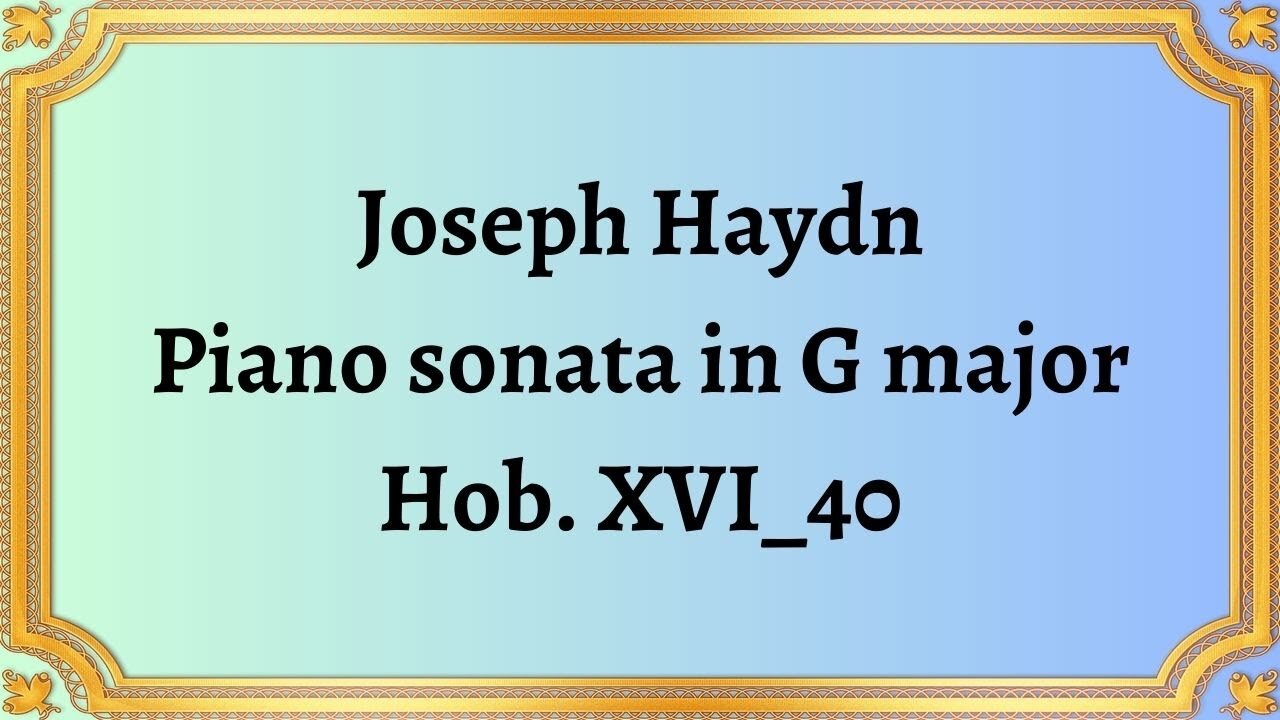Premium Only Content

Joseph Haydn Piano sonata in G major, Hob. XVI_40
#JosephHaydn #Pianosonata #Gmajor #HobXVI40 #sonataform #Classicperiod #keyboardmusic #counterpoint #harmony #structure #musicalanalysis #musicappreciation #classicalmusic #musiceducation
Joseph Haydn's Piano Sonata in G major, Hob. XVI_40 is a significant and well-known composition in the repertoire for solo piano. Its technical intricacies, melodic beauty, and harmonic brilliance have secured its place in music history as one of Haydn's masterpieces.
The sonata consists of three movements that follow traditional sonata form. The first movement is marked as Allegro, featuring a radiant and uplifting thematic exposition full of crisp and free-flowing notes. Haydn then develops this theme in a variety of keys before returning to the original exposition in the recapitulation.
The second movement is marked Adagio, which is slower and has a more lyrical character. It features serene, tender, and melancholic melodies that are augmented by intricate counterpoint. In the middle section of the movement, Haydn changes key and embarks on a searching passage, showcasing his innovative and daring creativity.
The final movement of the sonata is marked as Presto, featuring a flurry of notes and technical virtuosity. The intricate passages and playful melodic phrases foreshadow Haydn's sense of humor and wit. The sonata comes to a lively and buoyant conclusion, leaving the listener energized and uplifted.
Haydn's Piano Sonata in G major was written during the Classic period, a time in musical history where music was focused on beauty, balance, and clear structures. This sonata is a perfect example of Classic musical structure and style, utilizing balance and symmetry throughout the sonata form. Haydn was one of the foremost composers of this period, a time where solo keyboard music had risen in popularity, alongside the development of the modern piano and increasing interest in instrumental music.
In conclusion, Joseph Haydn's Piano Sonata in G major, Hob. XVI_40, is a work of tremendous significance in the repertoire for the solo piano. Its beauty, technical virtuosity, and historical importance have made it a classic work of music. Haydn's use of classical structures, innovative harmonic decisions and his mastery of counterpoint has made Piano Sonata in G a lasting contribution to music history, securing it as an immortal composition.
You have the opportunity to support the channel https://destream.net/live/RadSiarAl/donate
-
 LIVE
LIVE
Dr Disrespect
5 hours ago🔴LIVE - DR DISRESPECT - DELTA FORCE - STARFALL NEW SEASON
2,510 watching -
 LIVE
LIVE
Revenge of the Cis
2 hours agoEpisode 1432: Take Two
2,107 watching -
 5:43:05
5:43:05
Bitcoin Magazine
6 days agoLIVE: Donald Trump Inauguration | America's First Bitcoin President
25.3K1 -
 1:04:13
1:04:13
In The Litter Box w/ Jewels & Catturd
18 hours agoINAUGURATION DAY | In the Litter Box w/ Jewels & Catturd – Ep. 723 – 1/20/2025
28.3K14 -
 3:20:22
3:20:22
Steven Crowder
8 hours agoCrowder Inauguration Day Live Stream 2025 | The Return of Donald Trump!
1.05M382 -
 3:54:12
3:54:12
vivafrei
6 hours agoTHE DON OF A NEW AMERICA! Trump Inauguration Live Stream! Viva Frei Live!
98.5K70 -
 3:42:54
3:42:54
The Quartering
1 day agoTrump Inauguration LIVE Broadcast & Commentary With DecoyVoice, Hannah Clare & Styxhexenhammer!
200K40 -
 6:25:30
6:25:30
LFA TV
1 day agoLIVE: INAUGURATION OF PRESIDENT DONALD J. TRUMP
291K79 -
 53:47
53:47
Russell Brand
6 hours agoInauguration Day Live! – SF522
185K93 -
 2:43:30
2:43:30
Donald Trump Jr.
8 hours agoFull Coverage of My Father’s Inauguration, America is Back. | TRIGGERED Ep.209
347K277